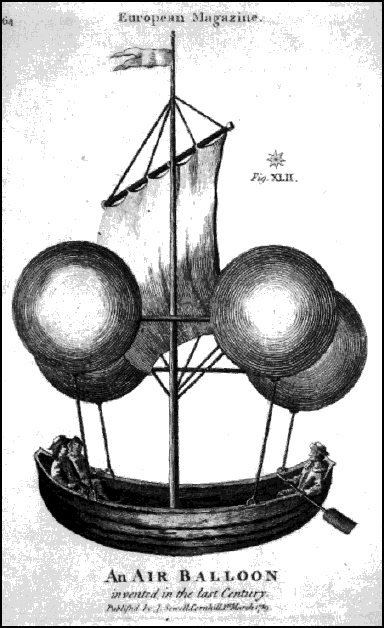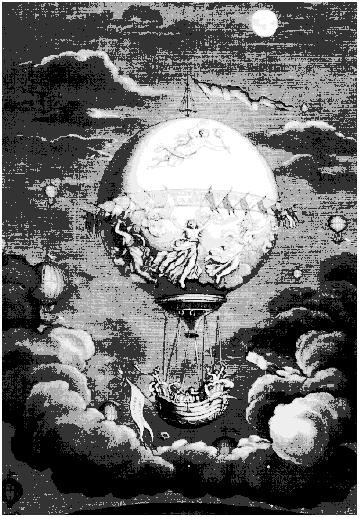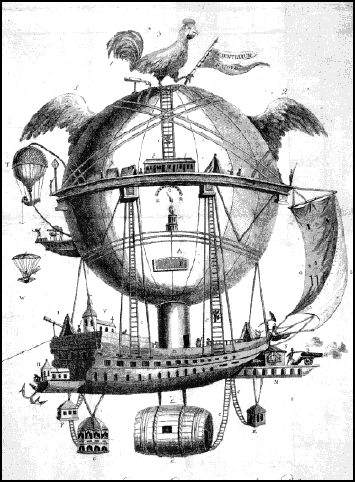Of Flight
The Aeronautical History Collection of
Colonel Richard Gimbel
Tom D. Crouch, Editor
(Friends of the
U. S. Air Force Academy and
The University of Washington)

His definition of flight was broad. It was to begin with angels --- but he found out that the cherubim guarding the tree of life didn't have wings. "So," he said,
I started with the Babylonian legend of Etana. Etana, a prince who could not have children and was worried about high taxes, was advised by holy men to consult an eagle. He found a beat-up eagle on a mountaintop, nursed it back to health, and talked it into flying to Heaven with him on its back.
Then there are the classical myths --- Alexander the Great being carried aloft by griffins; Dædalus and Icarus fashioning their own wings; Sinbad pulled aloft by a giant roc --- but the earliest book on more normal modes of flight dates from 1489, Historia Alexandri Magni.
 There are books with descriptions of early helicopter toys (1325), kites (1591), and balloons. The first recorded balloon flight was that of de Gusmao of Brazil in 1709. The second was produced by the Brothers Montgolfier of France in 1787. Several of the brothers' balloons anticipated later animal transports: two centuries before Sputnik the Montgolfiers sent up a sheep, a duck, a rooster, and then, finally, a people. All, apparently, lived.
There are books with descriptions of early helicopter toys (1325), kites (1591), and balloons. The first recorded balloon flight was that of de Gusmao of Brazil in 1709. The second was produced by the Brothers Montgolfier of France in 1787. Several of the brothers' balloons anticipated later animal transports: two centuries before Sputnik the Montgolfiers sent up a sheep, a duck, a rooster, and then, finally, a people. All, apparently, lived.
There are illustrations of Count von Zepplin's first flight in the LZ6 in 1900 and Otto Lilenthal's many gliders (he eventually crashed and died in 1896). And, of course, there are many documents from days of the Wright Brothers, including the first reports of their flights in Dayton, starting in 1904, in Gleanings in Bee Culture (the editor, not a bee, was a fan of theirs).
The words are all well and good: the wonder of this volume is the 300 or so illustrations, color drawings, and photographs, splendidly reproduced. Our special favorites include
- The tale of Peter Wilkins' mythical journey, à la Icarus, from Cape Horn to England (1751);
- The circumnavigation of the globe in a boat lofted by four copper balloons (1768) --- written in the style of Virgil;
- An airship complete with boat, kegs, cannon, sails and rooster, by Etienne Gaspard Robertson (1820);
- 36 Views around Mount Fuji [from a kite];(1825)
- The monster balloon of Provençe (complete with stovepipe) (1839);
- "The Boy's Own Toy-Maker: A Practical Illustrated Guide to the Useful Employment of Leisure Hours" (1859) --- which includes how-to-do-it "fire balloons, two kinds of parachutes, and four varieties of kites;"
- "A Few Remarks on What Has Been Done with Screw-Propelled Aero-Machines," by F. J. Stringfellow (1892);
- Frank Reade, Jr's "Air Wonder, The Kite; or A Six-Weeks' Flight over the Andes" (1902);
- "Darius Green and his Flying-Machine" (1910);
- "Tom Swift and His Air Glider" (1912);
- "Hike and the Aeroplane," by Sinclair Lewis (1912); and, best of all,
- "The Aerostatic Man, or My Poor Uncle," who became levitated because he accidentally got injected with "inflammable air" in his posterior "which caused him to fly from his bed and out the window" (the nephew implored readers to help him find his uncle).
This is a glorious collection, exquisitely bound (complete with CD-Rom). It is a credit to the University of Washington Press and the USAF Academy. Long may they wave!
